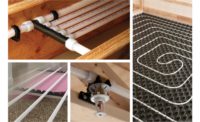Since they first became available in the United States around 1930, weld fittings have continuously gained acceptance as the most effective and economical pipe joining method for many industrial applications. In many industries welded piping systems have replaced their predecessors -- the threaded and/or flanged designs.
This is an updated version of the product training course introduced by Supply House Times in 1979, authored by Don Arnold.
Made In Many Materials
Weld fittings are butt-welded to the pipe or flange, which is why they are also commonly referred to as "butt weld" fittings. They are made in carbon steel, alloy steel, stainless steel, aluminum and exotic alloys for high temperature and highly corrosive applications. Weld fittings are generally wrought(made from pipe, rather than by forging or plate). While carbon steel weld fittings are primarily made from seamless pipe, stainless steel weld fittings are made from both welded pipe and seamless pipe.
Most standard wall and thinner stainless weld fittings are made from welded pipe; heavier wall stainless fittings are usually made from seamless pipe.
Permanently Leak-Proof
Weld fittings gained wide acceptance by the majority of designers, engineers and end users because of the many advantages of all-welded piping systems. The biggest advantage is being permanently leak-proof, thus requiring little or no maintenance for the life of the system.
In cases of thermal applications requiring insulation, the permanent welded joint precludes the need of removing insulation for maintenance, servicing leaking gaskets or tightening bolts. The leak-proof welded joint insures greater safety for the workers and the surrounding environment, particularly where the lines are subject to high internal pressure.
Strongest Piping
The great strength of welded joints is another factor in their selection. Welded joints are as strong or sometimes even stronger than the pipe itself, providing years of dependable, maintenance-free service. The pressure rating of a flanged connection (using the same wall pipe) is downgraded to the sealing capability of the gasket. Similarly, the pressure rating of a threaded connection (using the same wall pipe) is downgraded to the sealing capability of the threaded fitting.Fits In Any Space
Weld fittings also have a unique flexibility that lend themselves to be close nested. This allows piping designers to tailor the systems to work in a limited space, to conform to the physical parameters of the building, terrain, or the position of equipment.
The weld joints are virtually flush with the pipe, which allows lines to be placed directly against walls, ceilings, equipment or other lines. True circularity and uniform wall thickness of weld elbows allow for them to be cut at odd angles and still align perfectly with the pipe.

